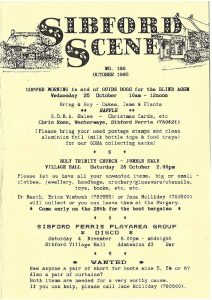Letter to the Editor - VJ Day
The VJ Day that never was.
From Burma to Sibford in 50 years.
There was a very nice letter from Jim Johnston in the June “Scene” about the VE Day Celebration in the Gower, but I didn’t attend this because I was under the impression that there was going to be another one for VJ Day.
Mr Johnston was in Brussels on VE Day 1945, but I was there in 1940 with the British Expeditionary Force, and most of the population had fled. When there was a Gas Warning with one of the German attacks, some of the people who were left came out with towels over their noses. A woman who could speak English told me she remembered the First World War, and gave me a small crucifix which I tied to the identification disc we had to wear around our necks. She said “Keep that my boy, and you will never go wrong.” And sure enough, I came through the whole war unscathed except for terrible bouts of malaria.
Finally we were told to make for Dunkirk. As a corporal in charge of transport, I was driving a 3-ton truck with all the battalion’s rations, but soon we were stopped and told to scuttle our trucks. When they realised I had all the rations for a thousand men, they told me to keep going! Three miles out of Dunkirk I was stopped again, and ordered to ditch my truck in the canal. I had three other drivers with me, so we started walking to the beach, but it certainly wasn’t a pretty sight. There were 3 big boats anchored just out at sea.
Then out of the blue, came Jerry with his dive bombers and in only a few minutes all our ships were alight. We were told that they were sending smaller craft that could get closer to the beach, so we queued up again – but without any luck. Then we decided to make for the docks, and luckily we found an old staff car loaded with officer’s uniforms; so we changed our old wet clothes for new dry ones! We got the car started and decided that if we couldn’t get on a boat, we would head for the south of France. However we managed to get on a destroyer, and in just over an hour we were back in Dover.
Back in dear old England we felt safe…what a relief it was! Soon we were on a train, but didn’t know where we were going. I finished up at Tenby in South Wales, in a posh hotel on the sea front. I think I must have slept for two days… but that was just the start of the war. we were soon sorted out, and sent up to Huddersfield where our 2nd Division was reforming.
We were put in civvy digs, and they really made a fuss of us! Then came the crunch… We found that only about half of us who went out to France had got back; so we were reinforced and put on to Coastal Defence, but we were very poorly armed – even with some wooden guns… But they looked good!
After a while we were equipped with entirely new transport, ready to go anywhere, as we were expecting Hitler to invade at any time. Since that didn’t happen we moved down south to Winchcombe near Cheltenham, and were fitted out with tropical kit but still didn’t know where we would be going. We had to dock our vehicles at Newport, but were sent up to Liverpool to get on a troopship. Anyway, after a few scares at sea we arrived at Capetown, where we stopped for about three weeks before learning that we were due to sail to Madagascar; however we were actually sent to Bombay instead!
At Bombay in 1942, we joined up again with the 14th Army, and I served with them in India, Assam and Burma for the rest of the war. After a disastrous campaign in the Arakan we had to retreat back to Bombay. Then in 1944, we were sent to Assam with orders to halt the Japanese at all costs. So we went to Dimapur by train, taking 14 days; then on to Kohima where our 2nd Division took the bulk of the fighting. This horrific battle was so costly of lives, that local tribesmen erected a huge memorial for all those who fell in retaking the town, with the telling inscription “When you go home, tell them of us, and say ‘For your tomorrow, We gave our today.'”
Kohima was the real turning point of the war in Burma; from then on we gave the Japs the full works all the way down to Rangoon; but even after Rangoon was ours, we had to wait till November 1946 before we could set sail for Dear Old Blighty.
I joined the Army in 1932, about the same time as two other lads from Sibford. Sadly, Archie Kaye was killed at Dunkirk, and John Long passed away about two years ago. I was a staff driver with the Royal Berkshires, and served in India, Egypt, Palestine, and Cyprus before being drafted to France with the B.E.F in 1939. So I had done almost 14 years before being demobbed, and was given the grand gratuity of £80 for it!
So, after 50 years, I thought I would polish up all my medals and wear them proudly to our local VJ Day. But that was not to be; for in Sibford, Britain’s 14th Army was the “Forgotten Army” once again!
Ex-Sgt S.A. Lines; 5334432.
The Royal Berkshire Rgt. (Sid)
